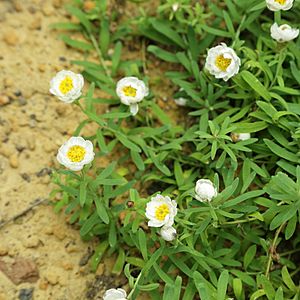Chamomile sunray facts for kids
Quick facts for kids Chamomile sunray |
|
|---|---|
 |
|
| Scientific classification | |
| Kingdom: | |
| (unranked): | |
| (unranked): | |
| (unranked): | |
| Order: | |
| Family: | |
| Tribe: |
Inuleae
|
| Genus: |
Rhodanthe
|
| Species: |
R. anthemoides
|
| Binomial name | |
| Rhodanthe anthemoides (Sieber ex Spreng.) Paul G. Wilson
|
|
| Synonyms | |
|
|
The Chamomile Sunray (scientific name: Rhodanthe anthemoides) is a beautiful plant. It belongs to the daisy family, just like sunflowers! This plant grows year after year, so it's called a perennial. You can only find it growing naturally in Australia.
This plant grows up to 40 centimeters (about 16 inches) tall. It can spread out to 60 centimeters (about 2 feet) wide. Its leaves are small, only about 10 millimeters long.
The flowers look like small daisies. They have a pale yellow center. Around the center are white, papery petals. These "petals" are actually special leaves called bracts. The flowers bloom from September to February in Australia. After the flowers, tiny dry seeds called achenes form. These seeds have soft, silky hairs.
About the Chamomile Sunray
The Chamomile Sunray is a type of flowering plant. It is part of the large Asteraceae family. This family includes many well-known flowers. Think of daisies, sunflowers, and chrysanthemums.
Where it Grows
This plant is found in several parts of Australia. You can see it in Queensland, New South Wales, Victoria, and Tasmania. It usually grows in sandy soil. You can often find it in mountain areas.
Even though it's common on the mainland, it's special in Tasmania. In Tasmania, it is listed as "rare." This means there are not many of these plants left there. It is protected under a law called the TSP Act.
Growing Your Own
Many people like to grow Chamomile Sunray plants. They are popular in gardens. If you want to grow one, it likes soil that drains water well. It also prefers a spot with some shade, not full sun all day.
After the plant finishes flowering, it's a good idea to trim it. This helps the plant stay neat. It stops it from becoming too long and messy. Chamomile Sunrays also grow well in pots or containers.
You can start new plants in two ways. You can plant seeds. Or, you can take small pieces of the plant, called cuttings. If you want a special type of Chamomile Sunray, you need to use cuttings. This makes sure the new plant is exactly like the parent plant.
Popular Types
Gardeners have developed many different types of Chamomile Sunray. These are called cultivars. Each one has slightly different features. Here are some popular ones:
- 'Annan Star'
- 'Chamomile Cascade'
- 'Milky Way'
- 'Paper Baby' - this one has red buds
- 'Paper Cascade' - also has red buds
- 'Paper Moon' ('Rhomoon')
- 'Paper Star' - a compact, smaller type
- 'Paper Trail' ('Rhotrail')
- 'Southern stars'
- 'Sunray Snow'

